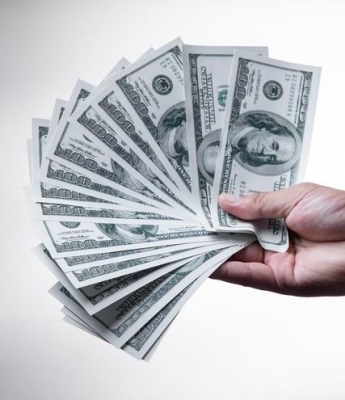By Arul LouisUnited Nations, May 6 : The dollar that has ruled the world at least since the end of World War II is now facing mutinies because of the US power to unilaterally impose sanctions and influence financial policies, as well as ideology and the rise of China as an international economic powerhouse.
A surge of financial crises facing several developing countries is another factor in nations looking for alternatives.
The challenges are still mutinies, with BRICS — the group of Brazil, Russia, India, China and South Africa — having a measure of credibility, but not a revolution.
Russia’s invasion of Ukraine and the sanctions imposed on the major energy exporter have brought a focus to the incipient mutinies brewing for a while.
This has been a catalyst for the BRICS to head a challenge that could have elements of credibility as never before.
Two of the members, China and India rank among the top five global economies, Brazil ranks eighth and Russia 11th giving it economic heft as they account for almost a quarter of the global gross domestic product.
A former special advisor at former President Donald Trump’s White House Council of Economic Advisers, Joseph Sullivan, said that a BRICS currency would pose a bigger challenge than individual currencies including the Yuan.
“It’d be like a new union of up-and-coming discontents who, on the scale of GDP, now collectively outweigh not only the reigning hegemon, the United States, but the entire G-7 (the group of major Western economies) weight class put together”, he wrote in the journal, Foreign Policy.
China, as the world’s top trading nation, has a vested interest in ousting the dollar, and Russia is forced by sanctions.
The driver for the other three is the energy imports from Russia.
The BRICS is seeking to increase the use of the members’ currency for mutual trade as a first step towards a common currency, according to South Africa’s BRICS envoy Anil Sooklal, who is preparing for the summit in June.
It is also getting membership requests from several countries that could be participants in dedollarised trade.
Many nations have joined the chorus questioning the might of the dollar.
Iran with an economy of a noticeable size was among the first to articulate dedollarisation in recent years as it faced the onslaught of sanctions even as it fashioned workarounds.
France with a history as an European ideological maverick is the latest to fire a warning shot, seemingly breaking ranks with the West: After a flamboyant visit to China, France’s President Emmanuel Macron told Politico that Europe should cut its dependence on the “extraterritoriality of the US dollar”.
Acknowledging the rise of China, he added that if tensions between the “two superpowers” rose “our strategic autonomy” will be compromised “and we will become vassals”.
Under President Lula Da Silva, Brazil is further pushing for dedollarising trade and moving to national currencies.
During a state visit to China, he denounced dollar dominance and said the developing countries should find an alternative to it.
Malaysia’s Prime Minister Anwar Ibrahim suggested creating an “Asian Monetary Fund”, also during a visit to China, according to China Daily.
Major energy exporter and investor Saudi Arabia’s Finance Minister Mohammed Al-Jadaan has also said that his country would be open to dedollarised trade.
Cryptocurrency promoters are a big, emerging constituency for dedollarisation hoping Bitcoin or another digital currency gets accepted.
But they are an amorphous group and cryptocurrency lacks state-backing or a credible regulator.
Meanwhile, countries like India and China have rolled out digital currencies that are essentially electronic versions of their existing currencies – and, in any case, large international transactions are done electronically.
There have been several scenarios painted for developing a BRICS currency.
Sooklal told the Russian news agency TASS that the greater use of national currencies by BRICS countries in investments and other transactions is also a prerequisite to moving on to a common currency.
He told Bloomberg that at the June summit, BRICS leaders will discuss expanding the group which has received 13 formal applications for membership and six have approached informally — and that would create a bigger bloc for dedollarisation, either mutually or through bilateral mechanisms.
New Development Bank (NDB), which is the BRICS developmental financial institution, is taking steps away from the dollar and plans to provide 30 per cent of the loans in local currencies, according to its president Dilma Rousseff.
The former president of Brazil told a Chinese TV station that using local currencies would help it lessen foreign exchange risks while reducing dependence on the World Bank and the International Monetary Fund.
Pavel Knyazev, Russia’s BRICS envoy said, “The possibility and prospects of setting up a common single currency based on a basket of currencies of the BRICS countries is being discussed,” according to Russia’s RT TV network.
The Deputy Chairman of the Russian Duma or parliament, Alexander Babakov, speculated on a new BRICS currency that will be secured by gold — and breaking a new path, with other products such as rare earth elements, according to the BRICS Portal.
Babakov also floated the idea of a BRICS “digital currency or any other fundamentally new form of currency in the near future”.
There are roadblocks for rivals to the dollar like the fact that the US currency is considered the most reliable one, with many countries investing in US treasury securities.
According to the US Treasury Department.China has $859.4 billion parked in US treasury securities; Japan $1.1 trillion, and India $232 billion.
Another is that the US is the top trading partner for many countries running deficits with them, including India with $133 billion of which exports accounted for $85.67 billion, and China $690.59 billion with $536.75 billion exports.
When there are wide disparities in trade, it would be difficult for countries that expect a big surplus in a currency to use it up.
That has been a factor in Russia, according to Reuters, stopping negotiations on using the rupee for trade.
But the move to trade in bilateral currencies has marched on.
China has been settling trade with several countries in yuan, notably Russia and Brazil, with Argentina recently saying that it would adopt it.
Even Bangladesh, beset by financial woes, has said that it would pay in yuan for a Chinese nuclear plant.
India’s Reserve Bank has announced that 18 countries, including Britain, Germany, Singapore and New Zealand, would be allowed to settle payments in rupees.
India’s new trade policy promotes rupee trade with countries with dollar shortages or currency crises.
India’s energy trade with Russia is mostly in dollars, but some are in other currencies like the United Arab Emirates (UAE) dirham.
The UAE and India are reported to be in talks for trading in dirham and rupee.
Out of the blue, a US Congressman has raised the possibility of India being “coerced” to make the rupee the BRICS currency and warned that it would be “in China’s best interest, not India’s”, but did not give a source for the claim.
If that were to happen, Mark Green, a Republican who heads the House of Representatives Homeland Security Committee and serves on the Foreign Affairs Committees wrote on Fox News, “With the United States out of the picture, China can take control of the world economy”.
“If the rupee becomes the currency for BRIC (sic), its value will increase significantly” lowering the cost of imports and increasing the prices of domestic products,” he wrote.
“This would be a bad thing – a very bad thing -for a large portion of India’s population”, he added.
(Arul Louis can be contacted at [email protected] and followed at @arulouis)
al/bg
#Dollars #credible #BRICS #Uma #Lal # Lal #China #Germany #Russia #Singapore #Idea #Bitcoin #Republican
.






